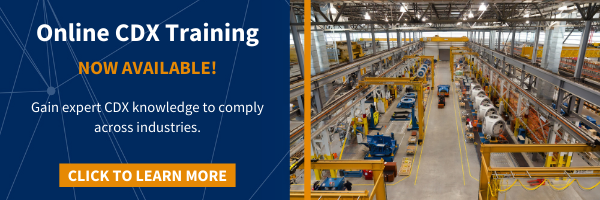Your products are only as good as your compliance. Without successful product compliance your products may be excluded from global markets, your business may face financial penalties, and you may lose the trust of your customers. Successful product compliance management is essential to keeping your compliance team working efficiently and successfully, allowing your products to reach their customers in a timely manner.
Compliance management best practices can help you build a successful product compliance program that is ready to meet global market challenges.
What is Compliance Management?
Compliance management is the process of monitoring future regulations to make sure that your systems, people, and processes are prepared for them. For product compliance, this means assessing the materials in your components and products to ensure they meet environmental compliance requirements.
Having a successful product compliance management program is essential for monitoring the chemical make-up of your products, communicating with the stakeholders in your supply chain, and reporting the required chemicals data to regulatory agencies and customers that will keep your products on the market.
Product Compliance Management Best Practices
Understand Your Legal Obligations
The first step to a successful product compliance management program is to understand your legal obligations. Depending on what jurisdictions your products are in, you may have a variety of legal regulations to meet.
For instance, in the European Union (EU), you will need to meet the reporting requirements for Registration, Evaluation, Authorisation and Restriction of Chemicals (REACH) and use the Substances of Concern in Products (SCIP) database, among other requirements. You may also find yourself with conflict minerals requirements to meet in the US and/EU, or perhaps you must meet California Prop 65 in the United States.
Understanding your legal obligations is the first, and most important step, in a successful product compliance program. Failing to meet legal obligations can lead to costly penalties and cause you to lose access to key markets.
Understand Customer Requirements
Beyond legal requirements, you will also need to understand your customer requirements. Some customers may ask their suppliers to expand the scope of their reporting and meet additional product compliance regulations or company-specific requirements.
You will need to understand exactly what your customers expect in order to meet their requirements and build a successful business relationship.
Understand Voluntary Standards
In addition to legal obligations and customer requirements, there may be voluntary standards your company wishes to meet. These may be sustainability standards or certifications, additional conflict minerals reporting, or other voluntary chemical data reporting.
While standards like these may not be required by regulatory agencies or customers, meeting them can go a long way in showcasing your company’s commitment to ethics and sustainability and building trust with your customers.
Train Your Compliance Staff
Having a well-trained staff is crucial to a successful compliance program. Product compliance can use a wide variety of tools—from customized spreadsheets to software databases such as the International Material Data System or the SCIP database.
Having an insufficiently trained staff using your systems can lead to costly compliance errors, either in the form of legal fines and penalties or loss of market access.
Train your team from the beginning, empowering them to work efficiently and find compliance success.
Communicate Effectively With Your Supply Chain
Effective supply chain communication is key to avoiding delays as your products move through the manufacturing process and make their way to your customers. If you have suppliers that don’t understand what you expect, you may face costly delays in meeting compliance requirements.
While some factors impacting supply chain delays may be outside of your control, clearly communicating with your supplies and customers to make sure everyone understands deadlines and requirements will reduce the likelihood of delays.
Use the Right Software Systems
Product compliance can require extremely large amounts of chemical data that needs to be reported accurately to various regulatory agencies and customers. Because of the significant data burden companies face, many choose to use a compliance software solution to make data entry more efficient.
Assessing both the cost of software solutions and the effectiveness of a solution for your company is important in making the right choice. Different companies have different compliance needs and must meet different requirements. Make sure your company is using the software system that best works for your requirements. This might mean using a similar software system as your customers for easier reporting or using a system that targets your specific type of requirements.
Uphold High Data Quality Standards
Materials compliance is all about your data. Having inaccurate data can lead to noncompliance, resulting in fines, eroded customer trust, and loss of market access.
Across your data reporting, make sure you are meeting the standards for high quality data. Consistently checking that you are meeting data quality standards will enable you to be ready for accurate compliance reporting without scrambling to find missing data.
Have Full Materials Declarations
One of the best ways to assure high quality data and efficient compliance reporting is to have full materials declarations for your products. This means that instead of analyzing your product to answer questions about particular substances, you consistently maintain a database of all materials and substances found in your products. Free systems like the Compliance Database Exchange (CDX) can help you do this.
Without a full materials declaration, every time a new regulation or requirement comes up, you must go back to your product and determine if it meets the regulations. A full materials declaration, however, makes your reporting much more efficient as the compliance answers you need are already at your fingertips.

Conduct Regular Internal Audits
While conducting internal audits may seem like an inefficient use of valuable time, regularly assessing your compliance systems can save you money in the long run. You should regularly conduct an audit of your compliance systems to makes sure they are operating efficiently, reducing bottlenecks, and reporting accurately.
Address Issues in a Timely Manner
When compliance issues arise—whether they are noncompliance issues or inefficiencies in reporting—it is best to address them as soon as possible. Waiting to correct compliance issues can be costly to your company, from the time wasted in inefficient reporting to the potential cost of noncompliance.
While it may be easy to get swept up in the day-to-day work of your company and think that you can solve a problem later, it is better to address an issue as soon as you see it to prevent it from becoming a bigger issue down the road.
Get Compliance Management Support from Tetra Tech
Keeping your products on track means effective compliance management. Whether you need to train your employees or need support in analyzing a compliance software solution, Tetra Tech’s team of compliance experts can help you. We have years of experience supporting compliance teams around the globe, and we can help you reach your compliance goals efficiently and create compliance systems that work for you.






